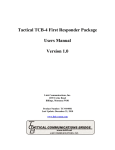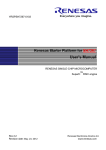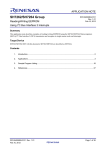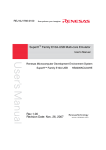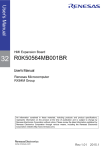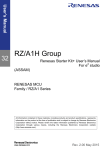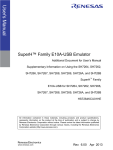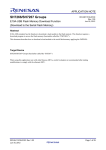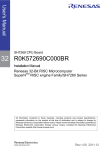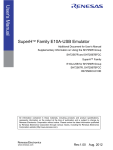Download Renesas Starter Kit2+ for SH7264 User`s Manual
Transcript
To our customers, Old Company Name in Catalogs and Other Documents On April 1st, 2010, NEC Electronics Corporation merged with Renesas Technology Corporation, and Renesas Electronics Corporation took over all the business of both companies. Therefore, although the old company name remains in this document, it is a valid Renesas Electronics document. We appreciate your understanding. Renesas Electronics website: http://www.renesas.com April 1st, 2010 Renesas Electronics Corporation Issued by: Renesas Electronics Corporation (http://www.renesas.com) Send any inquiries to http://www.renesas.com/inquiry. Notice 1. 2. 3. 4. 5. 6. 7. All information included in this document is current as of the date this document is issued. Such information, however, is subject to change without any prior notice. Before purchasing or using any Renesas Electronics products listed herein, please confirm the latest product information with a Renesas Electronics sales office. Also, please pay regular and careful attention to additional and different information to be disclosed by Renesas Electronics such as that disclosed through our website. Renesas Electronics does not assume any liability for infringement of patents, copyrights, or other intellectual property rights of third parties by or arising from the use of Renesas Electronics products or technical information described in this document. No license, express, implied or otherwise, is granted hereby under any patents, copyrights or other intellectual property rights of Renesas Electronics or others. You should not alter, modify, copy, or otherwise misappropriate any Renesas Electronics product, whether in whole or in part. Descriptions of circuits, software and other related information in this document are provided only to illustrate the operation of semiconductor products and application examples. You are fully responsible for the incorporation of these circuits, software, and information in the design of your equipment. Renesas Electronics assumes no responsibility for any losses incurred by you or third parties arising from the use of these circuits, software, or information. When exporting the products or technology described in this document, you should comply with the applicable export control laws and regulations and follow the procedures required by such laws and regulations. You should not use Renesas Electronics products or the technology described in this document for any purpose relating to military applications or use by the military, including but not limited to the development of weapons of mass destruction. Renesas Electronics products and technology may not be used for or incorporated into any products or systems whose manufacture, use, or sale is prohibited under any applicable domestic or foreign laws or regulations. Renesas Electronics has used reasonable care in preparing the information included in this document, but Renesas Electronics does not warrant that such information is error free. Renesas Electronics assumes no liability whatsoever for any damages incurred by you resulting from errors in or omissions from the information included herein. Renesas Electronics products are classified according to the following three quality grades: “Standard”, “High Quality”, and “Specific”. The recommended applications for each Renesas Electronics product depends on the product’s quality grade, as indicated below. You must check the quality grade of each Renesas Electronics product before using it in a particular application. You may not use any Renesas Electronics product for any application categorized as “Specific” without the prior written consent of Renesas Electronics. Further, you may not use any Renesas Electronics product for any application for which it is not intended without the prior written consent of Renesas Electronics. Renesas Electronics shall not be in any way liable for any damages or losses incurred by you or third parties arising from the use of any Renesas Electronics product for an application categorized as “Specific” or for which the product is not intended where you have failed to obtain the prior written consent of Renesas Electronics. The quality grade of each Renesas Electronics product is “Standard” unless otherwise expressly specified in a Renesas Electronics data sheets or data books, etc. “Standard”: 8. 9. 10. 11. 12. Computers; office equipment; communications equipment; test and measurement equipment; audio and visual equipment; home electronic appliances; machine tools; personal electronic equipment; and industrial robots. “High Quality”: Transportation equipment (automobiles, trains, ships, etc.); traffic control systems; anti-disaster systems; anticrime systems; safety equipment; and medical equipment not specifically designed for life support. “Specific”: Aircraft; aerospace equipment; submersible repeaters; nuclear reactor control systems; medical equipment or systems for life support (e.g. artificial life support devices or systems), surgical implantations, or healthcare intervention (e.g. excision, etc.), and any other applications or purposes that pose a direct threat to human life. You should use the Renesas Electronics products described in this document within the range specified by Renesas Electronics, especially with respect to the maximum rating, operating supply voltage range, movement power voltage range, heat radiation characteristics, installation and other product characteristics. Renesas Electronics shall have no liability for malfunctions or damages arising out of the use of Renesas Electronics products beyond such specified ranges. Although Renesas Electronics endeavors to improve the quality and reliability of its products, semiconductor products have specific characteristics such as the occurrence of failure at a certain rate and malfunctions under certain use conditions. Further, Renesas Electronics products are not subject to radiation resistance design. Please be sure to implement safety measures to guard them against the possibility of physical injury, and injury or damage caused by fire in the event of the failure of a Renesas Electronics product, such as safety design for hardware and software including but not limited to redundancy, fire control and malfunction prevention, appropriate treatment for aging degradation or any other appropriate measures. Because the evaluation of microcomputer software alone is very difficult, please evaluate the safety of the final products or system manufactured by you. Please contact a Renesas Electronics sales office for details as to environmental matters such as the environmental compatibility of each Renesas Electronics product. Please use Renesas Electronics products in compliance with all applicable laws and regulations that regulate the inclusion or use of controlled substances, including without limitation, the EU RoHS Directive. Renesas Electronics assumes no liability for damages or losses occurring as a result of your noncompliance with applicable laws and regulations. This document may not be reproduced or duplicated, in any form, in whole or in part, without prior written consent of Renesas Electronics. Please contact a Renesas Electronics sales office if you have any questions regarding the information contained in this document or Renesas Electronics products, or if you have any other inquiries. (Note 1) “Renesas Electronics” as used in this document means Renesas Electronics Corporation and also includes its majorityowned subsidiaries. (Note 2) “Renesas Electronics product(s)” means any product developed or manufactured by or for Renesas Electronics. User’s Manual Renesas Starter Kit2+ for SH7264 User’s Manual RENESAS SINGLE-CHIP MICROCOMPUTER SuperH™ RISC engine Rev.1.00 2010.01 Disclaimer By using this Renesas Starter Kit+ (RSK2+), the user accepts the following terms. The RSK2+ is not guaranteed to be error free, and the entire risk as to the results and performance of the RSK2+ is assumed by the User. The RSK2+ is provided by Renesas on an “as is” basis without warranty of any kind whether express or implied, including but not limited to the implied warranties of satisfactory quality, fitness for a particular purpose, title and non-infringement of intellectual property rights with regard to the RSK2+. Renesas expressly disclaims all such warranties. Renesas or its affiliates shall in no event be liable for any loss of profit, loss of data, loss of contract, loss of business, damage to reputation or goodwill, any economic loss, any reprogramming or recall costs (whether the foregoing losses are direct or indirect) nor shall Renesas or its affiliates be liable for any other direct or indirect special, incidental or consequential damages arising out of or in relation to the use of this RSK2+, even if Renesas or its affiliates have been advised of the possibility of such damages. Precautions This Renesas Starter Kit is only intended for use in a laboratory environment under ambient temperature and humidity conditions. A safe separation distance should be used between this and any sensitive equipment. Its use outside the laboratory, classroom, study area or similar such area invalidates conformity with the protection requirements of the Electromagnetic Compatibility Directive and could lead to prosecution. The product generates, uses, and can radiate radio frequency energy and may cause harmful interference to radio communications. However, there is no guarantee that interference will not occur in a particular installation. If this equipment causes harmful interference to radio or television reception, which can be determined by turning the equipment off or on, you are encouraged to try to correct the interference by one or more of the following measures; • ensure attached cables do not lie across the equipment • reorient the receiving antenna • increase the distance between the equipment and the receiver • connect the equipment into an outlet on a circuit different from that which the receiver is connected • power down the equipment when not is use • consult the dealer or an experienced radio/TV technician for help NOTE: It is recommended that wherever possible shielded interface cables are used. The product is potentially susceptible to certain EMC phenomena. To mitigate against them it is recommended that the following measures be undertaken; • The user is advised that mobile phones should not be used within 10m of the product when in use. • The user is advised to take ESD precautions when handling the equipment. The Renesas Starter Kit does not represent an ideal reference design for an end product and does not fulfil the regulatory standards for an end product. ii Table of Contents Chapter 1. Preface .................................................................................................................................................. 1 Chapter 2. Purpose ................................................................................................................................................. 2 Chapter 3. Power Supply ........................................................................................................................................ 3 3.1. Requirements ............................................................................................................................................... 3 3.2. Power–up Behaviour .................................................................................................................................... 4 Chapter 4. Board Layout ......................................................................................................................................... 5 4.1. Component Layout ....................................................................................................................................... 5 4.2. Board Dimensions ........................................................................................................................................ 6 Chapter 5. Block Diagram ....................................................................................................................................... 7 Chapter 6. User Circuitry......................................................................................................................................... 8 6.1. Switches ....................................................................................................................................................... 8 6.2. LEDs ............................................................................................................................................................. 8 6.3. Potentiometer ............................................................................................................................................... 9 6.4. Serial port ..................................................................................................................................................... 9 6.5. Debug LCD Module ...................................................................................................................................... 9 6.6. RCAN ......................................................................................................................................................... 10 6.7. USB ............................................................................................................................................................ 10 6.8. ETHERNET ................................................................................................................................................ 11 6.9. LCD Interface ............................................................................................................................................. 12 6.10. SSI ............................................................................................................................................................ 12 6.11. SD Card .................................................................................................................................................... 13 6.12. Video Decoder .......................................................................................................................................... 14 6.13. Option Links.............................................................................................................................................. 15 6.14. Oscillator Sources .................................................................................................................................... 19 6.15. Reset Circuit ............................................................................................................................................. 19 Chapter 7. Modes.................................................................................................................................................. 20 7.1. Boot modes ................................................................................................................................................ 20 7.2. Clock operating modes ............................................................................................................................... 20 Chapter 8. Programming Methods ........................................................................................................................ 21 Chapter 9. Headers ............................................................................................................................................... 22 9.1. Generic Headers ........................................................................................................................................ 22 9.2. Generic TFT LCD Header .......................................................................................................................... 24 Chapter 10. Code Development ........................................................................................................................... 26 10.1. Overview................................................................................................................................................... 26 10.2. Compiler Restrictions ............................................................................................................................... 26 10.3. Breakpoint Support ................................................................................................................................... 26 10.4. Memory Map............................................................................................................................................. 27 Chapter 11. Component Placement ...................................................................................................................... 28 iii Chapter 12. Additional Information........................................................................................................................ 30 iv Chapter 1. Preface Cautions This document may be, wholly or partially, subject to change without notice. All rights reserved. Duplication of this document, either in whole or part is prohibited without the written permission of Renesas Technology Europe Limited. Trademarks All brand or product names used in this manual are trademarks or registered trademarks of their respective companies or organisations. Copyright © 2010 Renesas Technology Europe Ltd. All rights reserved. © 2010 Renesas Technology Corporation. All rights reserved. © 2010 Renesas Solutions Corporation. All rights reserved. Website: www.renesas.com Glossary ADC Analog to Digital Converter PC Personal Computer CD Compact Disc RAM Random Access Memory CPU Central Processing Unit RCAN Renesas Controller Area Network DAC Digital to Analog Converter ROM Read-Only Memory E10A ‘E10A for Starter Kits’ Debugger RSK Renesas Starter Kit EMC Electromagnetic compatibility RSK2+ Renesas Starter Kit plus ESD Electrostatic Discharge SCI Serial Communication Interface HEW High-Performance Embedded Workshop SD Secure Digital H-UDI Hitachi - User Debug Interface SDRAM Synchronous I/O Input / Output LCD Liquid Crystal Display LED Light Emitting Diode MCU Microcontroller Unit Dynamic Random Memory 1 SPDIF Sony/Philips Digital Interface SSI Serial Sound Interface USB Universal Serial Bus Access Chapter 2. Purpose This RSK is an evaluation tool for Renesas microcontrollers. Features include: • Renesas Microcontroller Programming. • User Code Debugging. • User Circuitry such as switches, LEDs and potentiometer(s). • Sample Application. • Sample peripheral device initialisation code. The RSK board contains all the circuitry required for microcontroller operation. This manual describes the technical details of the RSK2+SH7264 hardware. The Quick Start Guide and Tutorial Manual provide details of the software installation and debugging environment. 2 Chapter 3. Power Supply 3.1. Requirements This CPU board can operate from a 5V center positive power supply. Table 3-1 and Table 3-2 below details the power supply connectors available on this RSK2+ board CN7 Pin CPU board Signal Name Pin CPU board Signal Name 1 5VCC 2 5VCC 3 GROUND 4 GROUND Table 3-1: Power Supply Connector CN7 CN8 Pin CPU board Signal Name Pin CPU board Signal Name 1 5VCC 2 NC 3 GROUND Note: The connector CN8 is fitted underneath the board. Table 3-2: Power Supply Connector CN8 Please refer to the following table for on-board power supply connections - Jumpers JP10 Setting Description Fitted 3.3V is supplied at 3VCC net Removed 3.3V supply is disconnected from 3VCC net Table 3-3: Power Supply Options for 3.3V Jumpers JP11 Setting Description Fitted 1.2V is supplied at 1.2VCC net Removed 1.2V supply is disconnected from 1.2VCC net Table 3-4: Power Supply Options for 1.2V Warning - Care must be taken to ensure that an appropriate supply is used. Failing to do this may cause permanent damage to the board. This RSK2+ board is supplied with an E10A debugger. This RSK2+ boards have a centre positive supply connector using a 2.0mm barrel power jack. Warning - The CPU board is not over voltage protected. Use a centre positive supply for this board. 3 3.2. Power–up Behaviour When the RSK is purchased the CPU board has the ‘Release’ or stand alone code from the example tutorial code pre-programmed into the Renesas microcontroller. On powering up the board, the user LEDs will start to flash. Pressing any switch will cause the LEDs to flash at a rate controlled by the potentiometer. 4 Chapter 4. Board Layout 4.1. Component Layout The following diagram shows the top layer component layout of the board. Reset Switch Power Connector Video Jack Header Power LEDs Microcontroller Pin Header JP8 JP15 Ethernet J12 TFT LCD Audio Jack MCU Analog POT User LEDs CN11 JP16 E10 A Header J6 VGA connector USB RS 232 Serial CAN User Switches Figure 4-1: Board Layout 5 Debug LCD Header USB Function & Host Connectors 4.2. Board Dimensions The following diagram gives the board dimensions and connector positions. Figure 4-2: Board Dimensions 6 Chapter 5. Block Diagram Figure 5-1 shows the CPU board components and their connectivity. Power Jack Option SD Card Connector Serial Flash 64 Mbit LCD Panel Connector NAND Flash 8 Gbit Video Decoder NOR Flash 512 Mbit TFT Header Microcontroller SDRAM 64 MB RCAN Connector Reset Pin RESET IC ADC inputs for the Switches Ethernet Connector USB Host and Function Connector Serial Sound Interface Connector ADC input SW2 SW3 SW4 SW5 SW6 SW7 SW8 SW9 SW10 SW 1 1 SW 1 2 SW 1 3 SW 1 5 SW 1 6 SW 1 7 SW Application Header 1 4 SWITCHES Debug Headers Option LEDs Serial Connector Option User : 3 Yellow LEDs Potentiometer Figure 5-1: Block Diagram Figure 5-2 shows E10A connections to the RSK2+ board. USB Cable Host PC E 10 A Module JP8 JP15 J12 MCU User Interface Cable CN11 JP16 J6 USB CPU Board Figure 5-2: E10A RSK2+ Connections 7 Power : Green (3.3V) Blue (5V) Chapter 6. User Circuitry 6.1. Switches There are 16 user switches connected in matrix form on the board in addition to the reset switch. They are connected to 4 ADC input Pins of the MCU. The function of each switch and its connection are shown in Table 6-1 Switch Function Microcontroller RST / SW18 When pressed, the microcontroller is reset. RES#, Pin 51 SW2 User Switch PH0/AN0, Pin 94 SW3 User Switch PH0/AN0, Pin 94 SW4 User Switch PH0/AN0, Pin 94 SW5 User Switch PH0/AN0, Pin 94 SW6 User Switch PH1/AN1, Pin 95 SW7 User Switch PH1/AN1, Pin 95 SW8 User Switch PH1/AN1, Pin 95 SW9 User Switch PH1/AN1, Pin 95 SW10 User Switch PH2/AN2, Pin 96 SW11 User Switch PH2/AN2, Pin 96 SW12 User Switch PH2/AN2, Pin 96 SW13 User Switch PH2/AN2, Pin 96 SW14 User Switch PH3/AN3, Pin 97 SW15 User Switch PH3/AN3, Pin 97 SW16 User Switch PH3/AN3, Pin 97 SW17 User Switch PH3/AN3, Pin 97 Table 6-1: Switch Functions 6.2. LEDs There are 6 LEDs on the RSK2+ board. The green ‘POWER’ LED (LED8) lit when a 3.3V supply is connected to the power net 3VCC and blue ‘POWER’ LED (LED7) lights when the board is powered with 5V. The three user LEDs are connected to an IO port and will lit when their corresponding port pin is set low. An Orange LED (D2) will light when Ethernet connection is established. Table 6-2 below shows the LED pin references and their corresponding microcontroller port pin connections. LED Reference (As Colour Microcontroller Port Microcontroller Pin function Pin Number shown on silkscreen) Polarity LED1 Yellow PJ6 62 Active Low LED2 Yellow PJ7 61 Active Low LED3 Yellow PJ8 50 Active Low Table 6-2: LED Port 8 6.3. Potentiometer A single-turn potentiometer is connected to pin AN6 (Port PH6, pin 101) of the microcontroller. This may be used to vary the input analog voltage value to this pin between AVCC and Ground. Note: The potentiometer is fitted to offer an easy way of supplying a variable analog input to the controller. It does not necessarily reflect the accuracy of the controller’s ADC. Please see the device manual for details. 6.4. Serial port The RS232 port is available at connector ‘CN1’ and uses microcontroller serial port SCIF3 for asynchronous serial communication. The board is designed to accept a straight-through RS-232 male-to-female cable. 6.5. Debug LCD Module The LCD module supplied with the RSK2+ can be connected to the connector ‘J6’ for use with the tutorial code. Any module that conforms to the pin connections and has a KS0066u compatible controller can be used. The LCD module uses a 4bit interface to reduce the pin allocation. No contrast control is provided; this must be set on the display module. The module supplied with the CPU board only supports 5V operation. Table 6-3 shows the pin allocation and signal names used on this connector. J6 (For LCD) Pin Circuit Net Name Device Pin Pin Circuit Net Name Device Pin 1 Ground - 2 5VCC - 3 No Connection - 4 PJ6 62 5 R/W (Wired to write only - 6 PJ8 (+ 10k pull down 50 using 10K pull down)) to ground) 7 No Connection - 8 No Connection - 9 No Connection - 10 No Connection - 11 PJ7 61 12 PJ9 48 13 PJ10 46 14 PJ11 44 Table 6-3: Debug LCD Module Connections 9 6.6. RCAN The SH7264 on-chip RCAN module offers a flexible and sophisticated way to organize and control CAN frames, providing the compliance to CAN2.0B Active and ISO-11898-1. There are 2 CAN channels available on the microcontroller but only one transceiver is available on the board. By default CAN0 is connected to the CAN transceiver. Option links provide easy interface to connect CAN1 channel to the transceiver instead of CAN0. Table 6-4 details the required connections to connect either CAN0 or CAN1 channel to the transceiver – CAN channel Option Links Option Links R277, R278 R275, R276 CAN0 Fitted Removed CAN1 Removed Fitted Note: The default CAN setting on this RSK2+ is indicated by BOLD text. Table 6-4: CAN Channel Selection Table 6-5 details the CAN connectors available on this RSK2+ board – CAN0 Pin Circuit Net Name Device Pin 1 CANH 75* 2 CANL 73* 3 GND - * - The RCAN transceivers translate the voltage levels on CPU pin to meet RCAN voltage level standards. Table 6-5: RCAN Connector For more details on SH7264 on-chip RCAN module, please refer to SH7264 Group Hardware Manual. 6.7. USB The USB 2.0 host/function module (USB) provides capabilities as a USB host and USB function. It supports high-speed and full-speed transfers defined by USB 2.0 specification. The Low speed mode is not supported. This module has a USB transceiver and supports all of the transfer types defined by the USB specification. The module has an 8-kbyte on-chip buffer memory for data transfer, providing a maximum of ten pipes. Any endpoint numbers can be assigned to PIPE1 to PIPE9, based on the peripheral devices or user system for communication. 10 Table 6-6 below details the USB connectors available on this RSK2+ board Pin No USB Socket-A (USB Host) USB Mini-B (USB Device / Function) JP1 (1-2) short JP1 (1-2) open Pin Name Circuit Net Device Pin Pin No Pin Name Name Circuit Net Device Pin Name 1 VBUS VBUS 84 1 VBUS VBUS 84 2 D- DM 82 2 D- DM 82 3 D+ DP 83 3 D+ DP 83 4 GND GROUND --- 4 ID USB_ID NC 5 FG2 USB_SHLD --- 5 GND GROUND --- 6 FG1 USB_SHLD --- 6 FRAME USB_SHLD --- 7 FG1 USB_SHLD --- 8 FG2 USB_SHLD --- 9 FG3 USB_SHLD --- Table 6-6: USB For more details on SH7264 on-chip USB module, please refer to SH7264 Group Hardware Manual. 6.8. ETHERNET The network functionality is provided by the SMSC LAN89218, a single-chip 10/100 Ethernet controller which incorporates essential protocol requirements for operating an Ethernet/IEEE 802.3 10BASE-T and 802.3u100BASE-TX node. The Ethernet controller is configured to use a 16 bit data bus. It uses single 16 bit read and write strobes. Byte accesses are not available for this device. The chip select used for the network controller is CS2. The orange LED (D2) lights when Full-Duplex connection is established between the PHY device and any other connected Ethernet devices. The embedded Ethernet connector green LED lights when there is a link with the other devices. The yellow LED lights when there is a network activity. Refer to the SMCS LAN89218 datasheet for more information on this peripheral. Table 6-7 contains details of the signal descriptions and pin connections. LED Reference Colour LAN89218 Port Pin LAN89218 Pin Number (As shown on silkscreen) DUPLEX Orange GPIO2_LED3# 100 Ethernet connector: LED_K_YELLOW Yellow GPIO0_LED1# 98 Ethernet connector: LED_K_GREEN Green GPIO1_LED2# 99 Table 6-7: Ethernet module settings 11 6.9. LCD Interface Video Display Controller 3 in SH7264 supports TFT-LCD panel. Video Display Controller 3 uses the display and recording function to store the input data in the memory and then display the video on the panel. Hitachi TX06D57VM0AAA TFT LCD panel has been used on RSK2+SH7264 board. This panel has a resolution of 240 x 320 pixels. This panel is fitted at CN11 connector. Table 6-8 below details the pin connections for CN11 connector available on this RSK2+ board CN11 (For Hitachi LCD) Pin CPU board Signal Name Device Pin Pin CPU board Signal Name Device Pin 1 GROUND --- 2 GROUND --- 3 GROUND --- 4 2_8VCC --- 5 2_8VCC --- 6 2_8VCC --- 7 GROUND --- 8 BLCD0_B1 144* 9 BLCD1_B2 143* 10 BLCD2_B3 141* 11 BLCD3_B4 139* 12 BLCD4_B5 137* 13 BLCD5_G0 136* 14 BLCD6_G1 135* 15 BLCD7_G2 134* 16 BLCD8_G3 133* 17 BLCD9_G4 132* 18 BLCD10_G5 131* 19 GROUND --- 20 BLCD11_R1 129* 21 BLCD12_R2 127* 22 BLCD13_R3 125* 23 BLCD14_R4 124* 24 BLCD15_R5 123* 25 BLCD_CLK 119* 26 BLCD_CL1_HSYNC 121* 27 BLCD_FLM_VSYNC 122* 28 BSSL1 114* 29 BRSPCK1 116* 30 BMOSI1 112* 31 BMISO1 111* 32 BRES# 51* 33 GROUND --- 34 VLED+ --- 35 VLED + --- 36 VLED- --- 37 VLED - --- 38 GROUND --- 39 GROUND --- * - These CPU pins are externally buffered (U30 and U31). Table 6-8: LCD Header CN11 6.10. SSI The serial sound interface (SSI) is a module designed to send or receive audio data interface with various devices offering Sony/Philips Digital Interconnect Format (S/PDIF) compatibility. It also provides additional modes for other common formats, as well as support for multi-channel mode. Both transmitter and receiver modules are embedded. Audio Codec pins are available at header ‘JP16’. 12 6.11. SD Card SD card memory interface is provided in this controller. Table 6-9 below details the SD Card header. J1 Pin Header Name Circuit Net Name Device Pin 1 CD/DAT3 SD_D3 184 3 VSS1 GROUND 5 CLK 7 Pin Header Name Circuit Net Name Device Pin 2 CMD SD_CMD 183 --- 4 VDD 3VCC_C --- SD_CLK 180 6 VSS2 GROUND --- DAT0 SD_D0 173 8 DAT1 SD_D1 172 9 DAT2 SD_D2 185 10 W_Protect SD_WP 171 11 Card_Detect SD_CD 170 12 COMMON GROUND --- Table 6-9: SD Card Header 13 6.12. Video Decoder The video display controller provides video display function, video recording function, utility for overlaying graphics images on the input video, and function for outputting the control signals for the TFT-LCD panel. Table 6-10 below details the Video Decoder header pin connections CN10 Pin Circuit Net Name Device Pin Pin Circuit Net Name Device Pin 1 PE5/DV_HSYNC/SDA2 174 2 RES# 51 3 PE4/DV_VSYNC/SCL2 175 4 PE3/SDA1 176 5 PF0/DV_DATA0 168 6 PE2/SCL1 177 7 GROUND --- 8 3VCC --- 9 PF8/DV_CLK 158 10 PF4/DV_DATA4 162 11 PF1/DV_DATA1 166 12 PF5/DV_DATA5 161 13 PF2/DV_DATA2 164 14 PF6/DV_DATA6 160 15 PF3/DV_DATA3 163 16 PF7/DV_DATA7 159 Table 6-10: Video Decoder Header CN10 Table 6-11 below details the VGA connector pin connections J9 Header Pin RSK2+ board Signal Name Header Pin RSK2+ board Signal Name 1 crt_red 2 crt_green 3 crt_blue 4 NC 5 GROUND 6 GROUND 7 GROUND 8 GROUND 9 NC 10 GROUND 11 NC 12 NC 13 LCD_CL1_HSYNC* 14 LCD_FLM_VSYNC* 15 NC Table 6-11: VGA Connector * - These CPU pins are connected through a NAND gate 14 6.13. Option Links In this section, the default configuration is indicated by BOLD text. Table 6-12 describes the function of the option links associated with LCD configuration. LCD interface Settings R209 R210 R212 R213 R211 R214 R215 R216 R217 R218 R219 R220 R221 R222 R224 R225 R226 LCD Interface LCD Interface LCD Interface LCD Interface LCD Interface LCD Interface LCD Interface LCD Interface LCD Interface LCD Interface LCD Interface LCD Interface LCD Interface LCD Interface LCD Interface LCD Interface LCD Interface Connects Clock pin 26 of DAC to Disconnects Clock pin 26 of DAC from GROUND GROUND Connects signal R0 of Video DAC to Disconnects signal R0 of Video DAC from ground ground Connects signal R1 of Video DAC to Disconnects signal R1 of Video DAC from ground ground Connects signal R2 of Video DAC to Disconnects signal R2 of Video DAC from ground ground Connects signal R3 of Video DAC to Disconnects signal R3 of Video DAC from PG11 (pin 129) of MCU PG11 (pin 129) of MCU Connects signal R4 of Video DAC to Disconnects signal R4 of Video DAC from PG12 (pin 127) of MCU PG12 (pin 127) of MCU Connects signal R5 of Video DAC to Disconnects signal R5 of Video DAC from PG13 (pin 125) of MCU PG13 (pin 125) of MCU Connects signal R6 of Video DAC to Disconnects signal R6 of Video DAC from PG14 (pin 124) of MCU PG14 (pin 124) of MCU Connects signal R7 of Video DAC to Disconnects signal R7 of Video DAC from PG15 (pin 123) of MCU PG15 (pin 123) of MCU Connects signal G0 of Video DAC to Disconnects signal G0 of Video DAC from ground ground Connects signal G1 of Video DAC to Disconnects signal G1 of Video DAC from ground ground Connects signal G2 of Video DAC to Disconnects signal G2 of Video DAC from PG5 (pin 136) of MCU PG5 (pin 136) of MCU Connects signal G3 of Video DAC to Disconnects signal G3 of Video DAC from PG6 (pin 135) of MCU PG6 (pin 135) of MCU Connects signal G4 of Video DAC to Disconnects signal G4 of Video DAC from PG7 (pin 134) of MCU PG7 (pin 134) of MCU Connects signal G5 of Video DAC to Disconnects signal G5 of Video DAC from PG8 (pin 133) of MCU PG8 (pin 133) of MCU Connects signal G6 of Video DAC to Disconnects signal G6 of Video DAC from PG9 (pin 132) of MCU PG9 (pin 132) of MCU Connects signal G7 of Video DAC to Disconnects signal G7 of Video DAC from PG10 (pin 131) of MCU PG10 (pin 131) of MCU 15 --- ------- ------- ------- ------- ------- --- R227 R228 R229 R230 R231 R232 R233 R238 R234 R268 LCD Interface LCD Interface LCD Interface LCD Interface LCD Interface LCD Interface LCD Interface LCD Interface LCD Interface LCD Interface Connects signal B0 of Video DAC to Disconnects signal B0 of Video DAC from ground ground Connects signal B1 of Video DAC to Disconnects signal B1 of Video DAC from ground ground Connects signal B2 of Video DAC to Disconnects signal B2 of Video DAC from ground ground Connects signal B3 of Video DAC to Disconnects signal B3 of Video DAC from PG0 (pin 144) of MCU PG0 (pin 144) of MCU Connects signal B4 of Video DAC to Disconnects signal B4 of Video DAC from PG1 (pin 143) of MCU PG1 (pin 143) of MCU Connects signal B5 of Video DAC to Disconnects signal B5 of Video DAC from PG2 (pin 141) of MCU PG2 (pin 141) of MCU Connects signal B6 of Video DAC to Disconnects signal B6 of Video DAC from PG3 (pin 139) of MCU PG3 (pin 139) of MCU Connects the BLANK pin of Video Disconnects the BLANK pin of Video DAC DAC to PG18 (pin 120) of MCU from PG18 (pin 120) of MCU Connects signal B7 of Video DAC to Disconnects signal B7 of Video DAC from PG4 (pin 137) of MCU PG4 (pin 137) of MCU Connects PJ2 pin of MCU to Disconnects PJ2 pin of MCU from LCD_M_DISP pin of TFT LCD LCD_M_DISP pin of TFT LCD connector connector (JP12) (JP12) --- ------- ------- ----R269, R275 Table 6-12: LCD Configuration links Table 6-13 describes the function of miscellaneous option links. Option Link Settings Reference Function Fitted Alternative (Removed) Related To R266 Touch Screen Connects ADGTRG pin to 3VCC Disconnects ADGTRG pin from 3VCC R267, R236 Connects IRQ0 pin of the MCU to 3VCC Disconnects IRQ0 pin of the MCU from R266, R236 Configuration R267 Touch Screen 3VCC Configuration R236 R275 Touch Screen Connects pin 2 of header ‘J12’ to port Disconnects pin 2 of header ‘J12’ from Configuration pin PC9 of MCU port pin PC9 of MCU CAN Connects PJ2 pin of MCU to CTX1 pin Disconnects PJ2 pin of MCU from CTX1 R268,R269 Configuration of voltage translator circuit in CAN pin of voltage translator. , R276 R275 R266, R267 module. R276 R277 CAN Connects IRQ1 pin of MCU to CXR1 pin Disconnects IRQ1 pin of MCU from CXR1 Configuration of voltage translator in CAN module. pin of voltage translator in CAN module. CAN Connects the CTX0 of MCU pin to Disconnects the CTX0 of MCU pin from pin 3 Configuration pin 3 of voltage translator in CAN of voltage translator in CAN circuit circuit 16 --- R278 CAN Connects the CRX0 of MCU pin to Disconnects the CRX0 of MCU pin from pin 3 Configuration pin 3 of voltage translator in CAN of voltage translator in CAN circuit --- circuit R53 R54 R281 R282 Serial Flash Connects RESET pin of Serial Flash to Disconnects RESET pin of Serial Flash Interface 3VCC from 3VCC Serial Flash Connects RESET pin of Serial Flash Disconnects RESET pin of Serial Flash from Interface to the CPU reset pin CPU reset pin Serial Flash Connects the D pin of Serial Flash to Disconnects the D pin of Serial Flash from Interface pin 3 of J10 connector pin 3 of J10 connector Serial Flash Connects the Q pin of Serial Flash to Disconnects the Q pin of Serial Flash from Interface pin 2 of J10 connector and MCU port pin 2 of J10 connector and MCU port pin PF2 R54 R53 --- --- pin PF2 SDRAM Pull down resistor for CKE pin of the Disconnects CKE pin of MCU from the Interface MCU Pull down resistor NAND Flash Connects the WP pin of NAND flash Disconnects the WP pin of NAND flash Interface memory to 3VCC memory from 3VCC NOR Flash Connects an external address line A25 Disconnects the address line A25 of MCU interface of MCU to pin 56 of NOR Flash memory from pin 56 of Nor Flash memory NOR Flash Connects an external address line A24 Disconnects the address line A24 from interface of MCU to pin 1 of NOR Flash memory pin 1 of Nor Flash memory NOR Flash Connects an external address line A23 Disconnects the address line A23 from interface of MCU to pin 2 of NOR Flash memory pin 2 of Nor Flash memory NOR Flash Connects an external address line Disconnects the address line A22 from pin interface A22 to pin 15 of NOR Flash memory 15 of NOR Flash memory R86 Video Decoder Pull up resistor for the MCU pin CLKINV Disconnects the pull up from CLKINV pin R90 R90 Video Decoder Connects CLKINV pin of Video Disconnects CLKINV pin of Video Decoder R86 Decoder to ground from ground R65 R32 R33 R34 R35 R36 ----- R37 R38 R39 R40 R1 Power Supply Connects 1.2VCC to PLL1.2V Disconnects 1.2VCC from PLL1.2V --- R252 Power Supply Connects 1.2VCC to UA1.2V Disconnects 1.2VCC from UA1.2V --- R251 Power Supply Connects 3VCC_CPU to UA3V Disconnects 3VCC_CPU from UA3V --- R250 Power Supply Connects 3VCC_CPU to AVcc Disconnects 3VCC_CPU from AVcc --- R253 Oscillator Connects X9 Crystal to EXTAL pin 57 Disconnects crystal ‘X9’ from EXTAL pin 57 --- of MCU of MCU R248 USB Parallel resistor for inductor L1 Parallel resistor removed --- R249 USB Parallel resistor for inductor L3 Parallel resistor removed --- R57 USB Connects 5V supply to the Supply Disconnects 5V supply from the supply pin of pin of power distribution switch U7 MIC2025 (U7) 17 R68 R78 R91 R280 R140 R141 R133 R134 Video Decoder Video Decoder User Port User Port Audio Interface Audio Interface Audio Interface Audio Interface Connects IIC bus address select (pin Disconnects IIC bus address select (pin 73) of Video decoder to 3VCC 73) of Video decoder from pull up circuit. Connects IIC bus control pin 73 of Disconnects IIC bus control pin 73 of Video Video decoder to ground decoder from ground Connects the control input pin 1 of Disconnects the control input pin 1 of multiplexer to the RES pin of MCU multiplexer from the RES pin of MCU Connects the control input pin 1 of Disconnects the control input pin 1 of multiplexer to PG20 (pin 118) of MCU multiplexer from PG20 (pin 118) of MCU Connects Data input pin 17 of Audio Disconnects Data input pin 17 of Audio driver driver to MCU port pin PE3 (pin 176) from MCU port pin PE3 (pin 176) Connects clock input pin 16 of Audio Disconnects clock input pin 16 of Audio driver to MCU port pin PE2 (pin 177) driver from MCU port pin PE2 (pin 177) Connects ADC and DAC sample rate Disconnects ADC and DAC sample rate clock pin 7 of audio driver to SSIWS0 clock pin 7 of audio driver from SSIWS0 (pin (pin 147) of MCU 147) of MCU Connects digital audio clock pin 8 of Disconnects digital audio clock pin 8 of audio audio driver to SSISCK0 (pin 148) of driver from SSISCK0 (pin 148) of the MCU R78 R68 R280, R92 R91, R92 ------- --- the MCU R135 R136 Audio Interface Audio Interface Connects ADC Data output (pin 9) of Disconnects ADC Data output (pin 9) of audio driver to SSIRXD0 (pin 146) of audio driver from SSIRXD0 (pin 146) of the the MCU MCU Connects DAC data input pin 10 of Disconnects DAC data input (pin 10) of audio audio driver to SSITXD0 (pin 145) of driver from SSITXD0 (pin 145) of the MCU --- --- the MCU R143 Audio Interface Connects chip select pin of audio Disconnects chip select pin of audio driver driver to AUDIO_X1 (pin 150) of the from AUDIO_X1 (pin 150) of the MCU --- MCU R139 R137 R146 R269 R283 Connects the analog output pin 21 of Disconnects the analog output pin 21 of audio driver to TP11 on board audio driver fromTP11 on board Connects the pin 1 of CN2 connector Disconnects the pin 1 of CN2 connector from to ground ground Connects the pin 4 of CN4 connector Disconnects the pin 4 of CN4 connector from to GPIO2 pin of audio driver GPIO2 pin of audio driver Ethernet Connects PJ2 (pin 71) of MCU to Disconnects PJ2 (pin 71) of MCU from chip Configuration Chip select pin of Ethernet select pin of Ethernet Ethernet Connects pin FIFO_SEL of LAN89218 Disconnects pin FIFO_SEL of LAN89218 Configuration to the external address pin A11 (pin 28) from the address pin A11 (pin28) of the of the MCU MCU Audio Interface MIC Headphone 18 ----- --R268, R275 R179 R284 R265 Ethernet Connects the interrupt request pin of Disconnects the interrupt request pin of Configuration Ethernet controller to IRQ1 pin (port Ethernet controller from IRQ1 (pin 70) of pin 70) of MCU MCU Ethernet Connects ‘endianess select’ pin of Disconnects ‘endianess select’ pin of Configuration Ethernet controller to the address Ethernet controller from the address pin A22 pin A22 (pin 43) of MCU (pin 43) of MCU --- --- Table 6-13: Miscellaneous Configuration links 6.14. Oscillator Sources Oscillators are fitted on the CPU board and used to supply various clock inputs to the Renesas microcontroller. Table 6-14 details the oscillators that are fitted and alternative footprints provided on this CPU board: Component Oscillator (X1) Fitted 25.175MHz LCD Clock Oscillator (X2) Not Fitted - For Test Purposes Crystal (X4) Fitted 32.768KHz Real Time Clock Oscillator (X5) Not Fitted - For Test Purposes Crystal (X6) Fitted 48 MHz USB Clock Oscillator (X7) Fitted 24.576MHz Video Decoder Clock Crystal (X9) Fitted 18 MHz System Clock Oscillator (OSC1) Fitted 13Mhz External DAC/ADC Clock Crystal (Y1) Fitted 25MHz Ethernet Clock Table 6-14: Oscillators / Resonators 6.15. Reset Circuit The CPU Board includes a Reset IC DS1819C (Q9) to meet the minimum reset period of 200 msec. The DS1819 monitor three vital conditions for a microprocessor: power supply, software execution, and external override. Please refer to the hardware manual for more information on the requirements of the reset circuit. Please check the reset requirements carefully to ensure the reset circuit on the user’s board meets all the reset timing requirements. 19 Chapter 7. Modes 7.1. Boot modes The boot modes supported by this RSK2+ board are listed in Note: Please ensure that SW1-6 is ON Table 7-1. Boot Mode 0 SW1-1 SW1-2 Description (MD_BOOT1 pin) (MD_BOOT0 pin) ON ON Boots the MCU, from the 4MB NOR flash memory (connected to the CS0 space) 1 ON OFF Boots the MCU, through high-speed communication, from the 8MB serial flash memory (connected to channel 0 of SPI interface) 2 OFF ON Boots the MCU from the 512 MB NAND flash memory (connected to the NAND flash memory controller interface) 3 OFF OFF Boots the MCU, through low-speed communication, from the 8MB serial flash memory (connected to channel 0 of SPI interface) Note: Please ensure that SW1-6 is ON Table 7-1: Boot Mode pin settings The default boot mode of this RSK2+ is indicated by BOLD text. For more information on the boot modes listed above, please refer to the SH7264 group hardware manual. 7.2. Clock operating modes This RSK2+ supports following clock operating modes Mode SW1-3 SW1-4 (MD_CLK1 pin) (MD_CLK0 pin) Clock Source 0 ON ON EXTAL or crystal resonator 1 ON OFF USB_X1 or crystal resonator 2 OFF ON EXTAL or crystal resonator 3 OFF OFF USB_X1 or crystal resonator Note: Please ensure that SW1-6 is ON Table 7-2: Boot Mode pin settings The default clock operating mode of this RSK2+ is indicated by BOLD text. For more information on the clock operating modes listed above, please refer to the SH7264 group hardware manual. 20 Chapter 8. Programming Methods The board is intended for use with HEW and the supplied E10A debugger. Refer to SH7262/SH7264 Group Hardware Manual for details of programming/ debugging without using these tools. 21 Chapter 9. Headers 9.1. Generic Headers Table 9-1 to Table 9-2 below show the standard generic header connections. Header Pin CPU board Signal Name Device pin Header Pin CPU board Signal Name Device pin 1 5VCC --- 2 3VCC --- 3 A22 43 4 PD15 186 5 A21 42 6 PD14 187 7 A20 41 8 PD13 188 9 A19 40 10 PD12 189 11 A18 39 12 PD11 190 13 A17 38 14 PD10 191 15 A16 34 16 PD9 194 17 A15 32 18 PD8 195 19 GROUND --- 20 GROUND --- 21 A14 31 22 PD7 196 23 A13 30 24 PD6 197 25 A12 29 26 PD5 198 27 A11 28 28 PD4 199 29 A10 27 30 PD3 200 31 A9 25 32 PD2 202 33 A8 23 34 PD1 204 35 A7 21 36 PD0 206 37 GROUND --- 38 GROUND --- 39 A6 20 40 PC0/CS0# 207 41 A5 19 42 PC1/RD# 208 43 A4 18 44 PC2/RD/WR# 1 45 A3 17 46 PC3/WE0#/DQML 2 47 A2 16 48 PC4/WE1#/DQMU 4 49 A1 15 50 PC5B/RAS# 8 51 PJ9/PWM2F/TEND1 48 52 PC6B/CAS# 9 53 PJ10/PWM2G/DREQ1 46 54 PC7B/CKE 11 55 PJ11/PWM2H/DACK1 44 56 PC8B/CS3# 13 Table 9-1: JP15 microcontroller header 22 Header Pin CPU board Signal Name Device pin Header Pin CPU board Signal Name Device pin 1 5VCC --- 2 3VCC --- 3 PC9 6 4 PH0/AN0 94 5 PC10 7 6 PH1/AN1 95 7 GROUND --- 8 PH2/AN2 96 9 SD_CD 170 10 PH3/AN3 97 11 SD_WP 171 12 GROUND --- 13 SD_D1 172 14 TP_AN4 98 15 SD_D0 173 16 TP_AN5 99 17 SD_CLK 180 18 NMI 52 19 SD_CMD 183 20 GROUND --- 21 SD_D3 184 22 SSISCK0 148 23 SD_D2 185 24 PJ0/CTX0/IETXD 75 25 GROUND --- 26 PJ1/CRX0/IERXD 73 27 SSITxD0 145 28 --- --- 29 SSIRxD0 146 30 --- --- 31 SSIWS0 147 32 GROUND --- Table 9-2: JP16 microcontroller header 23 9.2. Generic TFT LCD Header Generic TFT LCD header connections are detailed in Table 9-3. JP12 Header Generic TFT LCD RSK2+ board Pin Header Name Signal Name Device Pin Header Generic TFT LCD RSK2+ board Pin Header Name Signal Name Device Pin 1 --- 3VCC --- 2 --- 3VCC --- 3 --- 3VCC --- 4 LCD15_R5 PG15 123 5 LCD14_R4 PG14 124 6 LCD13_R3 PG13 125 7 LCD12_R2 PG12 127 8 LCD11_R1 PG11 129 9 LCD10_G5 PG10 131 10 LCD9_G4 PG9 132 11 LCD8_G3 PG8 133 12 LCD7_G2 PG7 134 13 LCD6_G1 PG6 135 14 LCD5_G0 PG5 136 15 LCD4_B5 PG4 137 16 LCD3_B4 PG3 139 17 LCD2_B3 PG2 141 18 LCD1_B2 PG1 143 19 LCD0_B1 PG0 144 20 --- GROUND --- 21 VLCD_CLK NC --- 22 LCD_CL1_HSYNC PG17 121 23 --- NC --- 24 --- NC --- 25 LCD_FLM_VSYNC PG16 122 26 LCD_DISP PG18 120 27 LCD_M_DISP LCD_M_DISP 71 28 --- GROUND --- 29 --- GROUND --- 30 --- GROUND --- Table 9-3: Generic TFT LCD Header 24 Generic MTU2 header connections are detailed in Table 9-4. J8 Header Pin RSK2+ board Signal Device Pin Header Pin RSK2+ board Signal Name Device Pin Name 1 PH6/AN6 101 2 PH7/AN7 103 3 GROUND --- 4 GROUND --- 5 PG21/RSPCK1/TIOC0A 116 6 PG22/SSL1/TIOC0B 114 7 PG23/MOSI1/TIOC0C 112 8 PG24/MISO1/TIOC0D 111 9 GROUND --- 10 GROUND --- 11 PJ6/TIOC1A 62 12 PJ7/TIOC1B 61 13 IRQ1 70 14 CS2 71 15 PJ4/RXD3 65 16 PJ5/TXD3 63 17 --- NC 18 --- NC 19 PJ8/PWM2E 50 20 --- NC Table 9-4: MTU2 Header Generic SPDIF header connections are detailed in Table 9-5. J10 Header Pin RSK2+ board Signal Device Pin Header Pin RSK2+ board Signal Name Device Pin Name 1 3VCC --- 2 SPDIF_OUT 151 3 SPDIF_IN 153 4 GROUND --- Table 9-5: SPDIF Header 25 Chapter 10. Code Development 10.1. Overview Note: For all code debugging using Renesas software tools, the CPU board must be connected to a PC USB port via an E10A. An E10A is supplied with the RSK2+ product. An E10A supplied with this kit is an on-chip debugging emulator which supports the H-UDI interface of the target device. The H-UDI uses a 14-pin interface and marked as E10A on the RSK2+SH7264 board. Due to the continuous process of improvements undertaken by Renesas the user is recommended to review the information provided on the Renesas website at www.renesas.com to check for the latest updates to the Compiler and Debugger manuals. 10.2. Compiler Restrictions The compiler supplied with this RSK2+ is fully functional for a period of 60 days from first use. After the first 60 days of use have expired, the compiler will default to a maximum of 256k code and data. To use the compiler with programs greater than this size you will need to purchase the full version tools from your Renesas distributor Warning: The protection software for the compiler will detect changes to the system clock. Changes to the system clock back in time may cause the trial period to expire prematurely. 10.3. Breakpoint Support Limited Event Conditions can be located in ROM code which is directly supported by E10A emulator. To enable breakpoints in RAM following command needs to be included in the script – > SH2A_SBSTK enable For more information on this, please refer to the SuperH™ Family E10A-USB Emulator Additional Document for User’s Manual for SH7264. 26 10.4. Memory Map The memory map shown in this section visually describes the memory areas of RSK2+SH7264. H’00000000 Vector Table H’000004E3 NOR FLASH 4MB H’003FFFFF H’08000000 Allocated to ethernet H’0BFFFFFF H’0C000000 SDRAM 64MB H’0FFFFFFF H'FFF80000 Internal RAM H’FFF8FC00 H'FFF90000 H’FFFFFFFF STACK Internal I/O REGISTERS Figure 10-1: RSK2+SH7264 Memory Map 27 Chapter 11. Component Placement Figure 11-1: Component Placement (Top Layer) 28 Figure 11-2: Component Placement (Bottom Layer) 29 Chapter 12. Additional Information For details on how to use High-performance Embedded Workshop (HEW), refer to the HEW manual available on the CD or installed in the Manual Navigator. For information about the SH7264 microcontrollers refer to the SH7264 Group Hardware Manual For information about the SH7264 assembly language, refer to the SH2A, SH2A-FPU Software Manual For information about the E10A Emulator, please refer to the E10A-USB Emulator User’s Manual Online technical support and information is available at: www.renesas.com/renesas_starter_kits Technical Contact Details America: [email protected] Europe: [email protected] Japan: [email protected] General information on Renesas Microcontrollers can be found on the Renesas website at: www.renesas.com 30 Renesas Starter Kit2+ for SH7264 User's Manual Publication Date Rev.1.00 25.JAN.2010 Published by: Renesas Technology Europe Ltd. Duke’s Meadow, Millboard Road, Bourne End Buckinghamshire SL8 5FH, United Kingdom ©2010 Renesas Technology Europe and Renesas Solutions Corp., All Rights Reserved. Renesas Starter Kit2+ for SH7264 User’s Manual 1753, Shimonumabe, Nakahara-ku, Kawasaki-shi, Kanagawa 211-8668 Japan REG10J0171-0100






































